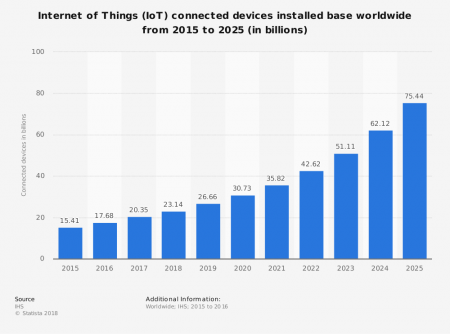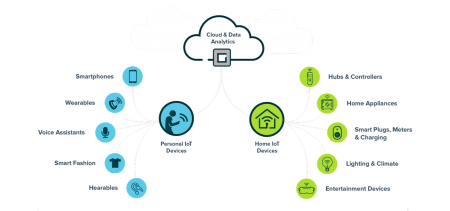March 22, 2019 – The Internet of Things or IoT is a disruptive force that is changing how our telecommunications networks are becoming more than a way for people to interact. Now it is a domain of interactive devices. There are already billions of them sending and receiving data. And soon enough they will morph well beyond that as smart cities, smart homes, and smart devices become ubiquitous.

Where is IoT catching on?
- Industrial sensors in manufacturing and warehousing
- Smart and autonomous vehicles
- Smart urban infrastructure
- RFID tags
- Healthcare devices
- Consumer wearables
- Home appliances
The biggest challenges to manage this explosive growth include:
- Bandwidth requirements as more IoT technologies connect to the Internet.
- Security and privacy infringements as people interact with IoT technology.
The bandwidth requirements are being handled by more radio spectrum auctions creating a bigger pipe for all the data sharing that IoT adds to the Internet. And the emerge of 5G networks means a dramatic increase in both feeds and speeds and volume.
But it is in the area of security where we need to focus our management of IoT. In the European Union this year, it has implemented the General Data Protection Regulation (GDPR) which will begin to be enforced this coming May. Although more focused on user interactions on the Internet, the GDPR has relevance to IoT related to the sharing of personal data collected by connected devices. IoT devices are built into processors and controllers, and therefore, have access to personal information. Think about when you buy a smart device and register it online. You enter personal data. It is, therefore, important that the information contained within or acquired by an IoT device be subject to the same privacy regulations of any other data on the Internet. That means IoT devices need to have a privacy design default.
In the United States IoT guidelines are set by the Federal Trade Commission (FTC) with the following recommendations:
- like the GDPR, privacy needs to be a lifetime design default for any IoT device and devices need to feature lockdown functions to keep unauthorized users from accessing them or the information contained on them and within the network.
- the public needs to be educated about IoT vulnerability related to information sharing.
- service providers need to ensure there are adequate layers of security in their network operations to provide a defense-in-depth against attempted denial-of-service attacks and other cybercriminal intrusions.
In 2017 a bill was introduced in the U.S. Senate that required IoT devices to include a list of security features before they could be purchased for government use. Although the bill did not pass that year, it has been resurrected in the current Congress and should get the votes in both houses to become the law of the land this year.
So who is pushing IoT technology? Here are twenty companies who have joined the IoT arms race:
- Amazon – the online retailer not only has Alexa, but is developing core software tools, and likely consumer and industrial sensor devices that will use its security protocols.
- Apple – the consumer device manufacturer has joined the Thread Group, a technology designed to interconnect IoT devices including home appliances, access control, climate control, energy management, lighting, safety, and security.
- ARM – the chip manufacturer has launched Project Trillium and chips with IoT capability for insertion into smart devices.
- AT&T – along with other wireless carriers are very much into putting IoT-capable sensors into the many layers needed to manage their vast communication networks.
- Bosch – the lens manufacturer has been developing a suite of IoT software tools for home automation and smart devices.
- Cisco – the network router giant is focusing on IoT-connected vehicles.
- Dell – the computer manufacturer is focusing on using IoT within computer devices and networks.
- Fujitsu – is working with Cisco, and Microsoft, among others on developing IoT for specific industrial applications from agriculture to transportation.
- General Electric – is working on integrating IoT technology into industrial processes, manufacturing, and preventive maintenance.
- Google – the search engine giant has built a Google Cloud IoT core development platform for a wide range of applications.
- Huawei – is strengthening its telecommunications core with a focus on IoT cloud and wireless technologies.
- IBM – is using its AI tool, Watson, to study the implementation of large-scale IoT in a wide range of industries and applications.
- Microsoft – has created Azure IoT as a development platform similar to Google’s.
- Oracle – the database provider has developed a Cloud IoT platform for integrating multiple devices and systems.
- Qualcomm – the telecommunications equipment provider is focusing on adding IoT capability to its chips, routers and other network devices.
- Samsung- has created the smart-IoT ARTIK software platform for incorporation into buildings, home appliances, and other devices it manufactures.
- SAP – the logistics and warehousing software giant is incorporating IoT analysis into its software to be able to take advantage of the deployment of smart devices and sensors.
- Siemens – is adding IoT analytics and devices to its many products and industrial processes.
- SnapThings – a unified platform for the deployment of IoT smart devices, gateways, mobile phones, and cloud systems.
- VxWorks – a real-time operating system engineered for IoT.
This above list is far from complete. New IoT startups are coming out of the woodwork these days and I suspect a year from now that we will have several significant players joining this group. After all, there is plenty of room in a market that projects the number of devices to go from 26 billion currently to more than 75 billion by 2025.









